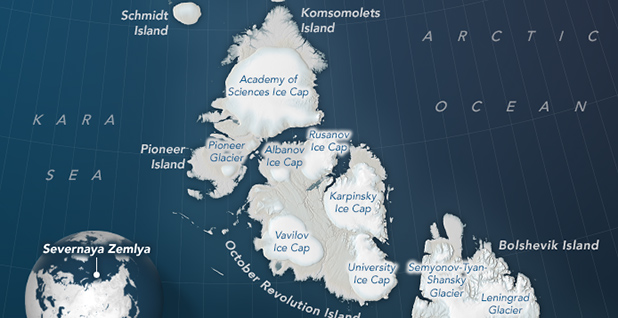A Russian Ice Cap Is Collapsing–It Could Be a Warning
High in the Russian Arctic, in the chilly waters straddling the Kara and Laptev, an 84-billion-ton island ice cap is projectile vomiting into the sea. Scientists say it could hold useful clues about what to expect as the world continues to warm.
The Vavilov Ice Cap, nestled in Russia’s Severnaya Zemlya archipelago, suddenly started to surge forward in 2013. This is not an uncommon event for glaciers — every so often, pressure will build up behind the ice and cause it to temporarily slip forward. These surge events can last anywhere from a few months to a year or more, and they’ll typically stabilize on their own.
But in 2015 — two years after the surge started — the Vavilov Ice Cap was still going. By then, it was moving faster than ever, flowing forward at a rate of about 26 meters per day and dumping 4.5 billion tons of ice into the sea over the course of a single year.
In total, Vavilov has lost about 9.5 billion tons of ice in the last six years.
Scientists monitoring the ice cap’s progress say it’s moved beyond a simple glacial surge. The rush of ice seems to have transitioned into a phenomenon known as an „ice stream,“ a long-lasting, fast-moving flow of ice out of the glacier and into the surrounding landscape — or, in this case, the sea.
Scientists know ice streams exist in frozen places around the world, including the Greenland and Antarctic ice sheets. But according to a new paper describing the events at Vavilov, this is the first time researchers have documented an ice stream’s formation from the very beginning.
Now that they’ve seen how it happens, the researchers say their observations may hold clues about the future of the world’s glaciers as global temperatures rise.
„Now we know these ice caps could be more unstable“ than previously believed, said lead study author Whyjay Zheng, a doctoral student at Cornell University. „We may possibly have to revise our future sea-level rise, considering this.“
Even when they appear to be stationary, glaciers are typically flowing forward — just so slowly it’s barely noticeable. There’s a reason for the phrase „moving at a glacial pace.“ Until 2013, Vavilov Ice Cap was likely inching forward at an imperceptible rate.
The researchers believe the ice first began to surge when it pushed past a mound of sediment on the landscape that had previously served as a barrier holding it back. When this happened, it slid onto a smoother patch of bedrock and slipped forward.
„You used to have a gate that constrained the ice, and then you lose this gate,“ Zheng said. „So all of this ice at a higher place just collapsed down into the ocean.“

The Vavilov Ice Cap is on a Russian island in the Arctic Ocean. NASA
Over time, as the movement of the ice accelerated, the scientists began to observe physical features that suggested the flow had morphed into an ice stream. Rifts and crevasses began to appear on the landscape around the moving ice, which showed up as dark stripes on satellite images. These cracks are typical features of ice streams.
While warming didn’t necessarily cause the initial surge, the researchers believe rising temperatures may be partly influencing the flow of ice, now that it’s on the move. During hotter summers — including unusually warm years in 2015 and 2018 — the researchers observed that the ice tended to flow even faster, slowing down again when the temperatures cool.
The scientists haven’t proved the temperatures are causing the faster ice flow, but they suspect there’s a connection. If so, it could mean even faster losses at Vavilov Ice Cap as the region warms.
Perhaps more importantly, the ice cap’s behavior has given scientists useful insight into the factors that cause ice streams to form in the first place. In Vavilov’s case, a shift in the bedrock beneath the ice seems to have been a key component. Afterward, faster ice flow seems to have helped the initial surge transform into a long-lasting, possibly permanent ice stream.
Scientists believe the much larger Greenland and Antarctic ice sheets may be vulnerable to these kinds of processes as temperatures rise.
Ocean-facing glaciers in Greenland and Antarctica are often stabilized by thick ledges of ice, or ice shelves, jutting out into the sea. A theory known as „marine ice sheet instability“ suggests that as ice shelves melt and weaken, glaciers may begin to slip backward along the bedrock beneath them, pouring ice into the ocean at faster speeds. Eventually, they may give way to unstoppable losses, which may empty entire glaciers into the sea.
While Vavilov is a comparatively tiny patch of ice, it’s demonstrated similar processes in action, the researchers say. A stabilizing barrier broke down and allowed the ice to surge forward. The ice never stabilized, and it’s now become a fast-flowing ice stream.
What this means for the future of the Vavilov Ice Cap remains uncertain. It’s still too early to tell whether the stream will slow down again — or, in a worst case scenario, eventually drain the ice cap from the face of the island.
„One thing we have to do is to continue to monitor this place,“ Zheng said. „Maybe for 10 more years or so.“
Reprinted from ClimateWire with permission from E&E News. E&E provides daily coverage of essential energy and environmental news at www.eenews.net.
If you want to read more science articles, you can visit our science category.
if you want to watch movies go to Film.BuradaBiliyorum.Com for Tv Shows Dizi.BuradaBiliyorum.Com, for forums sites go to Forum.BuradaBiliyorum.Com .



